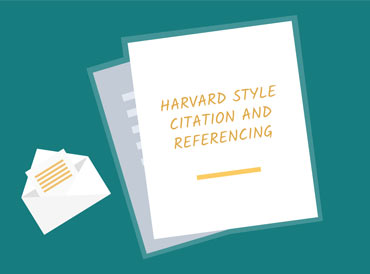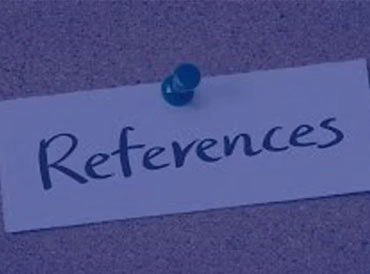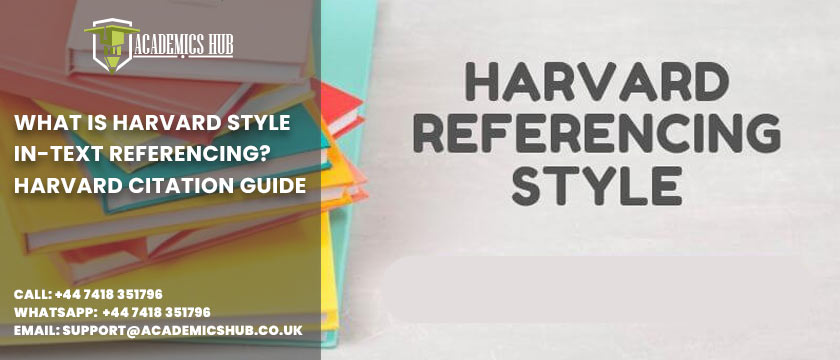We employ in-text references or citations to acknowledge the contributions of others and their ideas. They help the reader distinguish between your writing and that of other authors by being placed next to the material that you have paraphrased or cited. Reference lists must contain all of the information cited in the text. Every time you take a quote or paraphrase something from a source in your writing, it is ethical to include an in-text referencing that directs the reader to the complete reference. Many referencing styles are in use currently. The most commonly used and well-liked citing format that utilizes the author-date system for in-text citations is the Harvard style. In Harvard style referencing, citations are included within brackets in the text. The last name of the author, the year of publication, and, if appropriate, a page number are all included in an in-text citation.
Along with APA, MLA, and Chicago, the Harvard style is one of the most widely used formatting types for academic writings. Harvard style lays rules and the general format of the document, such as the preferred font and margin size. Additionally, it includes guidelines for Harvard citation and in-text referencing in the text as well as in the list of references given at the end of the article. Students usually are asked to submit their thesis, research and dissertations in a specific style which requires good exposure and skillset. Students find it difficult to follow the set of rules which is why they seek professional thesis help or dissertation help. If you too are wondering who will write my dissertation for me, that too in accordance with the Harvard citation guide, get a consultation from the experts.
Harvard Style In-Text Referencing
Before getting into Harvard style in-text referencing, let’s just understand the two elements referencing consists of:
In-text Citations

Included citations within your text and count toward your word limit are known as in-text citations. An in-text citation lists the author(s) and the year that a source was published. If no publication date is specified, the words “no date” are substituted in their place. If you are quoting directly from the source or referring to a specific passage, you must also include the page number(s), if available, or the paragraph number for websites.
Full References
References are those that are listed alphabetically in the reference section at the end of your paper and are not counted against the word count. All the sources you have cited in the body of your text are fully referenced with complete bibliographic data.
Harvard Style In-Text Referencing Guide
General Rules:
Cite Each Source You Use
You must provide a Harvard style in-text citation to indicate the source of any information you utilize in your paper. If not, your writing will be regarded as duplicated.
Exact quotes

If you use exact quotation marks from a source and include the page number in your in-text citation, you are following the Harvard referencing style. If you take words from a website, you must cite the specific paragraph number, as in this example: (Jim & Carol 2015, para. 3). Simply add up the number of paragraphs on the website you are referring to.
In-Text Citations’ General Format
Using the Harvard citation format, the author’s last name and the year of publication are placed in parentheses. They appear as follows: 2018 (Collins & Watson). Including the page, a number is also an option (Collins & Watson 2018, p. 89).
Mentioning an Author Who Has Been Mentioned in Another Source
The name of the original author should be mentioned when referencing a writer in Harvard style who is discussed in a secondary source, but you should also note that this writer is “cited in” the secondary source you are utilizing.
The Texts Mentioning Writers
Don’t put the authors’ names in parentheses when you reference them in the text. Additionally, use the word “and” for the ampersand (&). In their book, Kim and John (2014, p. 15), for instance, make the notion that jumping from a height might be harmful to your health.
Multiple Sources in A Single Citation
You should list your sources in the same order that they appear in your Reference List and use a semicolon to separate them if you want to mention more than one source in a single set of parentheses. For example: (Ben 2017; Trump 2011).
No Authors
Use the title of the source in your Harvard style in-text citation if the authors are not identified. For books, brochures, magazines, and reports, the title is italicized according to the Harvard style of referencing. However, whether you have to cite a website, article, newspaper, or chapter name, the title is enclosed in single quotation marks. The title’s first word should only be capitalized.
Typical Mistakes with In-Text Citations
Your sentences shouldn’t have the in-text citations in brackets as their subjects. Anything that is necessary to a sentence’s meaning should be written outside brackets:
Thomson (2019) contends that
Jones (2019) claims
Similar to this, avoid using the same author’s name in both the sentence and the citation in brackets:
According to Maddison (Maddison, 2005),
According to Mclean (2001)
Citing online or electronic sources
What exactly are digital sources?
Any information source that is digitally formatted is an electronic source. The library has access to a variety of electronic information sources for the benefit of its patrons. Full-text journals, newspapers, business information, e-books, dictionaries, encyclopedias, economic data, digital photographs, industry profiles, market research, etc., are only a few examples of the types of electronic sources available.
When citing them, should you provide further details?
It can be confusing to cite electronic or online sources because you aren’t always sure what information to include or where to go for it. As a general rule in Harvard style, give as much information as you can about authorship, availability, and location.
Much of the same information is needed for electronic and internet sources as it is for print sources (author, year of publication, title, and publisher). However, in some circumstances, more details might be needed:
As many electronic or online sources don’t have pages, what you cite will rely on the information available, such as the page, paragraph, or section number.
- Determine the source’s format, such as an e-book, a podcast, etc.
- Give an exact access date for sources found online
- Give the website address of an online resource, like a database.
Referencing sources with incomplete information
There are situations when you won’t have complete access to the sources you require for a Harvard style in-text citation. Here’s what to do if you don’t have a source’s publication date, author, or page numbers.
No date
Replace the date with the words “no date” if a source didn’t explicitly state when it was published, as is occasionally the case with online sources or old documents.
No author
You may occasionally be able to substitute a corporate author or the company or organization in charge of the publishing when it’s unclear who wrote a source:
No page numbers
If the material you’re quoting is brief and comes from a source lacking page numbers, such as a website, you can merely skip this information because it should still be simple to locate the quote. Finding an alternative position identifier, such as a paragraph number or subheading, and including that is preferable if you are quoting from a longer source without page numbers:
(Google, 2019, para. 14)
SAMPLE IN-TEXT REFERENCES IN HARVARD STYLE
EXAMPLE: 1

Younger drivers are more likely than any other group to suffer injuries or fatalities on our roads (VicRoads 2014). Young drivers face a variety of safety challenges, including attention problems. According to the World Health Organization, driver distraction is “when any type of externally occurring triggering event results in the driver diverting attention away from the driving activity” (2011, p. 8). While driving, being distracted by the ring of a phone, reading a text message, or answering a call are all possible. Because they lack the knowledge to know how to react, young drivers are more likely to be in an accident due to a distraction within the car (World Health Organisation 2011). Different people have different ideas about how to stop young people from using their phones while driving. As two potential options, Young, Rudin-Brown, and Lenne (2010) advocate stiffer penalties and driver education. Technology might offer a solution in the not too distant future.
EXAMPLE: 2
Students typically lack the writing, reading, and research abilities needed to finish assessment activities when they first start college. These abilities must be acquired gradually (Veit & Gould 2010). Students must develop their note-taking and paraphrasing skills if they want to write without using any plagiarized material. When paraphrasing, Veit and Gould (2010, p. 158) stress the necessity of “using your own words and your own style.” Students have access to a wide variety of note-taking and paraphrasing tools. In order to prevent accidental plagiarism, Veit and Gould (2010) advise rewriting significant information in your own words as you read. Always remember to include all source information in your notes, students. In the text, sources can then be properly cited.
Final Words
References are used in a piece of writing using the Harvard style of referencing both in the text and in a reference list at the end. Generally, every author whose name occurs in the text must also be listed in the references, and every work listed in the references must also be mentioned in the main text. Even the full stops and commas in the reference are significant. Harvard style in-text citations call for the author’s family name and the publication year. Using a quote, you should also include the word or a page number.
Students, when asked to submit their thesis or final year dissertations, seek online thesis help or dissertation help so that their paper can be referenced properly. The Harvard citation guide mentioned above includes all the basic and general rules that are required for Harvard style in-text referencing.

